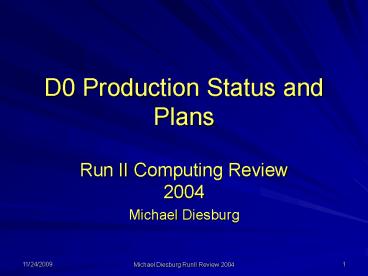D0 Production Status and Plans PowerPoint PPT Presentation
1 / 10
Title: D0 Production Status and Plans
1
D0 Production Status and Plans
- Run II Computing Review 2004
- Michael Diesburg
2
Reconstruction Farm Status
- Current Configuration
- 8 processor SGI Origin, 4GB memory, 2GB disk
- Used as NFS server, output staging area
- 19 dual processor PIII nodes
- Used as input stagers for production nodes
- 368 dual processor worker nodes (PIII, Athlon,
Xeon) - 1225 GHz total capacity (PIII equivalent)
- Software components
- FBSNG Fermilab farm batch system
- Dfarm distributed disk cache (used for code
distribution) - FCP farm copy (controls network copy load)
- SAM Used for all data I/O
- Local control scripts
3
Reconstruction Farm Status
- Current Operating Performance
- Have demonstrated operating efficiency gt 80
- i.e. can utilize gt 80 of rated capacity for
periods of months - Current demand on resources (since Jan 04) has
been 60 of capacity. - This is nearly ideal match of demand and
available resources - Reconstructed data available in SAM in 48 hours
- Special requests can be satisfied in lt 24 hours
- Capacity available for new tasks (TMB fixing)
- Can catch up from down periods in a few days
- Can reconstruct 3.5M events/day if average
execution time is 25GHz-secs/event.
4
Reconstruction Farm Status
- Operating Performance Projections
- Production capacity is strongly dependent on
luminosity of the data being processed - Average reconstruction time is 25 secs/event at
initial luminosity of 35E30, 65 secs/event at
70E30, (110 secs/event at 90 E30) - To produce 3.5M events/day at L gt 35E30 we will
be dependent on duty cycle mismatch between farm
and accelerator - With current configuration we can keep up with
data collection to 75E30 assuming accelerator
duty cycle of 1/3. - But, will lose advantages of excess capacity
noted above. - Operational efficiency will also suffer
5
Reconstruction Farm Status
- Farm Expansion Plans
- Will add 80 3GHz nodes to farm this year
- Will bring total capacity to 1500 GHz (PIII)
- With this addition we should be able to keep up
with data collection to 85E30 - Need HDCF ready by October in order to have
these nodes available at end of current shutdown - Will also move nodes currently in NML to HDCF
- Will upgrade input staging node connections to GB
- Will move some functionality off IRIX to Linux
- FBS, Dfarm server
- SAM station
6
Reconstruction Farm Status
- Farm Expansion Plans
- Operational software needs updating
- Current software is very robust and allows high
efficiency operation - Not very flexible (tailored to specific
executables) - Not portable (very specific to FNAL installation)
- Will shift to non-process specific, non-site
specific system - Plan on moving to samGRID as soon as possible
- Need to maintain efficiency of operation as cut
over is made - Will allow us to more easily shift operation
between reconstruction, Monte Carlo,
post-processing - Also will make us interoperable with remote
sites.
7
Monte Carlo Production Status
- MC Production
- All MC production has been done off-site
- Utilized 13 sites in 8 countries over the last
year - Brazil Czech Republic Denmark France
- Germany India UK US
- Expect additional sites to come online in next
year in - Canada China Korea US
- Difficult to characterize the potential capacity
since resources are not all dedicated - Generated 37M events last year (Max 1.5M/week)
- Usually very little delay between request
submission and start - Generation time 1-2 weeks (depends on site)
- Demand varies significantly during year
- Currently have idle capacity
8
Reprocessing Status
- Reprocessing, Round I
- Planning for reprocessing run began June 2003
- Required 5 ½ months preparation until startup
- Most time spent on making p14 version of reco
sufficiently robust to proceed - Significant changes in reco capabilities lead to
rethinking entire processing chain and priorities - Began reprocessing 15 Nov 2003, finished 5 Jan
2004 - 100M events processed at remote sites
- 25TB data transferred
- Final merging, storage of TMBs done at FNAL to
reduce load on remote sites, processing done from
DSTs (no Db access) - ½ FTE required at each remote site for duration
of processing phase
9
Reprocessing Status
- Reprocessing, Round II
- Scheduled to begin Dec 2004
- Scale of task 10x first round of reprocessing
- 1000M events (100M first round)
- 250 TB data (25 TB first round)
- Remote sites will do merging and final storage to
SAM - Processing from raw data rather than DST (DB
access required, data unfiltered) - Expect to require 6-8 months for completion
- Expect to use samGRID at all sites for Round II
- Biggest problem likely to be manpower
- 1 FTE/site for 6-8 months is significant burden
10
Production Status
- Conclusions
- Local production going well, but will have
difficulties next year as luminosity increases - Monte Carlo production in good shape but subject
to non-uniform demand - First round of remote reprocessing was major
success, second round to start soon. Manpower
demands will be significant issue

